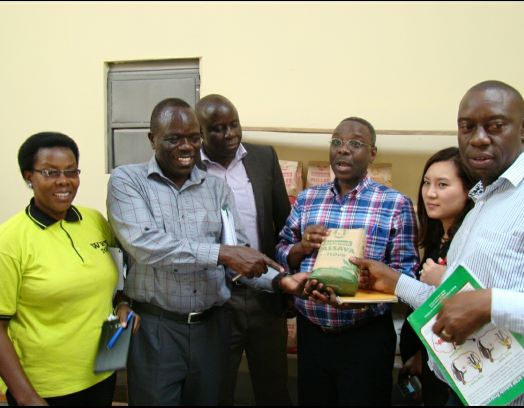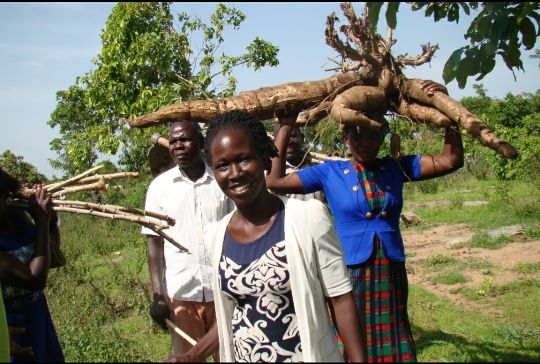
The Minister Of Agriculture, Animal Industry, and Fisheries Hon. Vincent Bamulangaki Ssempijja, has revealed the Agriculture Cluster Development Project (ACDP), which was introduced by the government to boost farming in various parts of the country, is performing exceedingly well, despite the challenges posed by the Coronavirus (COVID-19) pandemic. He noted that so far the government has released over Shs7.7Bn to farmers group across the country under ACDP.
Minister Ssempijja revealed this in the speech he delivered at the Uganda Media Centre, Kampala, mid this week, during which he revealed that the government is injecting USD150M in the Agriculture Cluster Development Project so as to spread model farming to 57 districts.
His Speech titled ‘Performance of the Agriculture Cluster Development Project’ is reproduced here below verbatim;
“I am here to update you on the Status and Performance of the Agriculture Cluster Development Project.
As we are all aware, the Country is currently facing numerous challenges like COVID 19; the rising levels of Lake Victoria and Lake Kyoga with associated suds; the Locusts invasion among others. These all combined together are having an adverse effect on Agriculture and are threatening our food security as a country.
The Ministry of Agriculture, Animal Industry and Fisheries, is making numerous efforts to mitigate some of these challenges by relentlessly continuing to work with farmers amidst these challenges.
The Mission of the Ministry is to transform subsistence farming into commercial agriculture. We recognise that a competitive, profitable and sustainable agricultural sector can be achieved through various strategies. One of the strategies and specifically at this moment, to keep the agro-based economy afloat is the work we do through projects such like ACDP.
Through a partnership with the World Bank, the Government of Uganda is investing USD150 million in the Agriculture Cluster Development project and being implemented in the 57 districts across the country, grouped into twelve geographical clusters; each cluster consisting of 3 to 7 districts.
ACDP Is Designed In Four Components;
1. The first component supports intensification of on-farm production through provision of subsidised inputs using electronic Management Voucher System (eVMS). Under this component, famers are supported to access inputs over 3 cropping cycles.
These include planting materials, fertilizers, agro-chemicals and post-harvest materials like haematic bags and tarpaulins. The cost of critical inputs in each cycle is estimated at USD 120.
So in the first cropping cycle, the farmer contributes 33% (USD 40), while Government under the project contributes 67% (USD 80); in the second cropping cycle, both the farmer and Government contribute 50% (USD 60); and finally in the third cropping cycle the farmer contributes 67% (USD 80), while Government contributes 33% (USD 40).
The farmers access this support electronically, where government only maintains a float account against which payments to agro-input dealer is initiated by the respective beneficiary farmer.
2. The second component supports post-harvest management, value addition and market access. The project supports two critical aspects; one is rehabilitation of community access road choke points. This is done in collaboration with the respective District Local Governments (DLGs). The second aspect is support to community based post-harvest and value addition infrastructures and facilities. The Farmer Group contributes 33% of the community project proposal while government under the project contributes 67% (≤ USD 75,000 per farmer group).
3. Strengthen policy and regulatory framework in input quality assurance. Under this component, the project supports MAAIF functions that include: policy development and implementation especially on regulation; development of water investments (irrigation feasibility studies and designs, and establishment of solar powered irrigation schemes at the ZARDIs); supports Fall Army Warm Control; and revitalisation of collection and analysis of agricultural administrative statistics.
4. And the fourth component is Coordination, Monitoring, Evaluation and ICT applications. This is basically for coordination and management including performance measurement (M&E) and development of IT solutions for agriculture.
The project targets farmers engaged in growing or dealing in any of the five commodities; Maize, Beans, Cassava, Rice and Coffee. The Government prioritized these crops as stated in the Agriculture Sector Strategic Plan for the Financial Years 2015/16 to 2019/20.
Purpose of the Media Briefing.
Therefore, the purpose of this media briefing is to give an update on the status of ACDP implementation and specifically on:
a) Status of beneficiary farmer access to subsidized input through the e-voucher management system (e-voucher).
b) Status of development of post-harvest handling and value addition infrastructures and facilities by the beneficiary Farmer Organizations.
c) Status of Rehabilitative works on Farm Access Road Chokes in the project beneficiary districts.
Project Fund Disbursements and Utilization
The project funding is USD 150 million, out of this USD 55.7 million (37%) has been disbursed and utilisation is at 16% of total loan (and 42% of disbursed amount).
The Ministry has hosted six World Bank Implementation Support and Review Mission (WBISRM), the sixth was held in November 18th – 28th 2019. In this (6th) WBISRM, the project performance was rated Moderately Satisfactory (MS) on account of the low disbursement against project age, which stood at 25%.

Farmer Access to Improved Agro-Inputs
The project is designed to benefit up to 450,000 farmers. So far 108,995 (42% of the targets) have been enrolled in the e-voucher system and 48,598 (11% of project target/ 45% of enrolled farmers) have received inputs
During this time of COVID lock-down and following the guidance of H.E the President and Ministry of Health Standard Operation Procedures (SOPs), the ministry working with accredited Agro-input dealers has supported up-to 23,726 farmers access improved technologies valued at UGX 7.7 billion.
The ministry is still working with these accredited Agro-input dealers to have up-to 13,877 famers access their inputs.
The quantity of inputs accessed by these farmers during this time is approximately 319.3 tons of seed (Maize, Rice and Beans), 2,671 bags of cassava cuttings and 8,442 tons fertilizer have been supplied, to beneficiary farmers across the 57 districts. The project is greatly stimulating demand and use of purchased quality production agro-inputs in the country to improve crop production and productivity.
Development of Post-Harvest and Value Addition Infrastructures and Facilities
In the First batch of Business plans, 117 Grant Agreements were signed on the 27th January, 2020 and Shs15 billion worth of Matching Grants have been disbursed to 77 Farmer Organisations from the districts of:
a) Rakai, Kalungu, Masaka, Kyotera and Mpigi in Cluster one
b) Iganga Bugiri, Namatumba and Bugweri in Cluster two
c) Amuru, Gulu, Omoro and Nwoya in Cluster six
d) Ntungamo, Isingiro Bushenyi, Rubanda, Rukiga and Kabale in Cluster eleven.
e) Arua and Yumbe in Cluster twelve.
During this lockdown and in line with the COVID-19 lock-down SOPs, the ministry has supported implementation of these community construction projects and so far some are already at roofing level.
Most of the facilities once completed will be equipped with drying or cleaning or value addition machinery. This will go a long way in addressing the chronic challenge of post-harvest losses as well as enable the farmers to add value to their produce for better incomes.

An additional Shs7.2 billion is expected to be disbursed by mid May 2020 as the respective Farmer Group beneficiaries are still mobilising their respective contributions towards their projects.
This project is indeed stimulating local savings and investment in agriculture. With the total value of the signed agreements of Shs34.9 billion, Government through the ACDP project’s contribution is Shs 23.4 billion (67%), while the beneficiary Farmer Groups are contributing Shs11.5 billion (33%). This is commendable and the approach should as much as possible be encouraged.
The response to this support has been tremendous and so far the ministry has received additional 186 business plans from 186 farmer groups; these have been appraised and 96 business plans worth Shs 36.8 billion recommended for grant award only pending site verification.
Rehabilitative Works on Farm Access Road Chokes
The ministry working with the respective District Local Government (DLG), Uganda Roads National Authority and the Ministry of Works and Transport identified, prioritized and developed Bill of Quantities (BoQs) and designs for rehabilitative works in the farm access roads choke points, in the five pilot districts of Kalungu, Iganga, Ntungamo, Nebbi and Amuru. These choke points impinge movement of agricultural inputs and produce.
During this lock-down and in line with the SOPs issued, contracts worth Shs12.4 billion have been signed to rehabilitate identified farm road choke points in the five pilot districts of Kalungu, Iganga, Ntungamo, Nebbi and Amuru.
On average four roads per district were identified and overall, 794 road chokes points shall be rehabilitated in the five pilot clusters.
In addition, during this time (lockdown), Bill of Quantities and designs are being reviewed for the 18 roll-out pilot clusters districts. While the surveys for the remaining seven rollout cluster districts is as well being done and expected to be concluded in June, 2020.
In conclusion therefore, amidst the COVID-19 challenges, the Ministry in close observance of the SOPs has continued to provide advisory, guidance to farmers in accessing improved agricultural technologies for increased productivity and production of these critical commodities supported under the ACDP project.
The Ministry has deployed staff at the respective cluster districts to support mobilization and enrolment of farmers into the e-voucher management system including supporting the redemption of agro-inputs, development of post-harvest infrastructures/facilities under the matching grants; and all preparation for rehabilitative works on road choke points in the community access.
I wish to once again thank all of you who have supported this exercise in one way or another in ensuring that these processes are a success. Interventions of ACDP will greatly contribute to our country’s desire to achieve food self-sufficiency, improve household income of small-holder farmers and import substitution. I continue to urge you to keep vigilant as we continue to support our farmers produce for both the domestic and export markets.”
